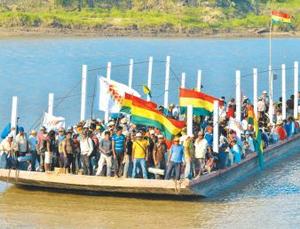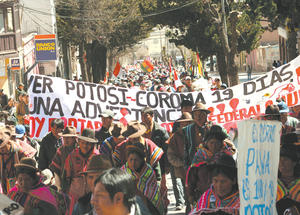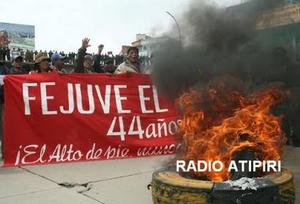It’s been a busy week in Bolivia, with major mobilizations by indigenous peoples in the Amazon, civic groups in Potosí, and neighborhood organizations in El Alto. Despite the government’s allegations of conspiracy, what’s striking about these protests is the diversity of their protagonists and agendas, and the shifting alignment of interests coalescing around each set of issues.
An estimated 1,000 indigenous residents of the TIPNIS reserve, together with supporters from the lowlands indigenous federation CIDOB and the highlands indigenous group CONAMAQ, began the 300+ mile trek from Trinidad to La Paz to protest the government’s plan to build a highway through their territory. Many arrived to the march by canoe  or on foot. Participants include veterans of the historic 1990 March for Dignity and Territory along the same route, as well as a new generation of younger activists—such as Anahí Dignidad Lider, born 21 years ago during the march and bearing its name.
or on foot. Participants include veterans of the historic 1990 March for Dignity and Territory along the same route, as well as a new generation of younger activists—such as Anahí Dignidad Lider, born 21 years ago during the march and bearing its name.
A number of groups that stand to benefit from the road formally registered their support for it this week, including the Chapare cocalero federations, Cochabamba factory workers, small business groups, and municipal associations, and elected officials of Villa Tunari and San Ignacio de Moxos at both ends of the route. But some allegiances were surprising. A faction of the Yuracarés, one of the three major indigenous groups in the park, endorsed the road, while the Beni Departmental Workers' Central and the Beni Civic Committee, which vigorously opposed indigenous land titling in 2008, sided with the protesters.
In a significant development, the national peasant confederation CSUTCB, which has consistently backed the government in its recent conflicts with popular movements (including the Gasolinazo), announced its opposition to the TIPNIS route. Still, some CSUTCB cocalero leaders who support the road have threatened to organize counter-mobilizations to block the march along the way. (The cocalero federations are also members of the CSUTCB.)
Some government officials suggested this week that alternative routes bypassing the park may be considered. Others maintained that “construction of the highway will save the park,” by establishing a stronger state presence to deter illegal loggers and narcotraffickers. The government has called on the protesters to dialogue, and insists that the march is unnecessary. The protesters say they will meet in La Paz or along the route, but only with President Evo Morales.
Elsewhere in Bolivia, popular organizations mobilized to demand more, not less, development from the government. In Potosí, a broad coalition of cooperative miners, peasant associations, and indigenous groups led by the civic organization COMCIPO held a massive demonstration to protest the government’s lack of progress in implementing the regional economic agenda agreed to last August, following a 19-day civic strike.
The agenda includes an international airport, a cement factory, a metal processing plant, resolution of an inter-departmental boundary dispute with neighboring Oruro, and the preservation of Cerro Rico (the mountain where Potosí’s  world-famous silver mines are located, which is now in danger of collapse). While the government claims that advances have been made during the past year, COMCIPO leaders are frustrated with what they perceive as slow progress.
world-famous silver mines are located, which is now in danger of collapse). While the government claims that advances have been made during the past year, COMCIPO leaders are frustrated with what they perceive as slow progress.
An initial meeting with government officials this week failed to achieve any results. COMCIPO has threatened to resume mobilizations if subsequent negotiations are not productive.
Meanwhile, in the indigenous city of El Alto, an “indefinite civic strike” (paro civico) was initiated early in the week by FEJUVE, the militant federation of neighborhood councils that was chiefly responsible for bringing down two neoliberal governments during the Gas Wars of 2003-2005. Their demand: to advance the 2012 national census to 2011, in order to increase the resources available to El Alto based on its 50% population growth over the past decade. (El Alto is now the second largest city in Bolivia, after Santa Cruz.)
While the city’s mayor blamed a lack of federal funding for his failure to implement planned infrastructure projects, federal government officials said that El Alto’s budget is considerably underspent, and also that advancing the census was infeasible. Other key organizations in El Alto, such as the municipal workers’ central, did not join in the strike. However, for two days, the mobilization was partially successful in blocking roads into La Paz and elsewhere.
However, for two days, the mobilization was partially successful in blocking roads into La Paz and elsewhere.
Here the MAS government fared somewhat better. After a six-hour negotiation in the presence of Evo Morales, a preliminary agreement was reached promising El Alto five new infrastructure projects, including an upgraded sports stadium and a hospital. However, two of FEJUVE’s 14 district councils refused to accept the settlement and are continuing their road blockades, for the moment.
Morales has been subject to harsh criticism in the international press this week for the proliferation of social conflicts, and especially for his double discourse on environmental issues at home and abroad. Overall, he has sought to downplay the protests by alleging that a “conspiracy” by domestic oppositional forces, or perhaps by USAID, is behind them.
With multiple sectors continue to press their demands amidst a complex and ever-changing set of alliances, it will take less rhetoric and a lot more direct intervention by Evo Morales to keep the lid on Bolivia’s social movements in the coming weeks and months.

